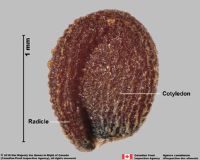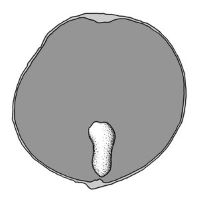Content is from Kirkbride et al. 2006Kirkbride et al. 2006:
Kirkbride JH, Jr, Gunn CR, and Dallwitz MJ. 2006. Family guide for fruits and seeds, vers. 1.0. Accessed September 2020-January 2022. URL: https://nt.ars-grin.gov/seedsfruits/keys/frsdfam/index.cfm ., without modification.
Updates are forthcoming.
Fruits: Pistil(s) compound; 1; 1-pistillate; with carpels united. Fruit anthocarpanthocarp:
simple or compound and including some tissue of non-ovarian origin (accessory tissue) ; compound; follicular anthecetum (Trithuria Spjut has 3 families: Centrolepidaceae, Hydatellaceae & Poaceae.); without persistent central column; within accessory organ(s), or not within accessory organ(s); within calyxcalyx:
; compound; follicular anthecetum (Trithuria Spjut has 3 families: Centrolepidaceae, Hydatellaceae & Poaceae.); without persistent central column; within accessory organ(s), or not within accessory organ(s); within calyxcalyx:
the outer whorl of the perianth; all the sepals of a flower (Hydatella); accrescentaccrescent:
(Hydatella); accrescentaccrescent:
growing continuously
; persistent; per fruit 1-seeded, or many-seeded (but many per female head); 1-seeded (per fruit, but many per female head); less than 1 cm long; 0.04–0.05 cm long; with 3-carpellate (assumed); with carpels separate (essentially); with carpels separating at maturity (assumed); without sterilesterile:
lacking male and/or female reproductive parts; also, not producing fruit or seed
 carpels; not sulcatesulcate:
carpels; not sulcatesulcate:
surface relief—having one or more elongate, relatively narrow and shallow depressions or grooves ; in transection tereteterete:
; in transection tereteterete:
approximately circular in cross section; width and thickness approximately equal
 (more or less); apexapex:
(more or less); apexapex:
the point farthest from the point of attachment, or the "tip" of an organ not beaked; wall chartaceouschartaceous:
not beaked; wall chartaceouschartaceous:
papery, papyraceous
(per fruitlet - but many carpels in fruiting head); dehiscentdehiscent:
(v. dehisce) splitting open at maturity to release contents (of a fruit) (Trithuria), or indehiscentindehiscent:
(Trithuria), or indehiscentindehiscent:
not opening on its own, as in a fruit
 (Hydatella). Dehiscentdehiscent:
(Hydatella). Dehiscentdehiscent:
(v. dehisce) splitting open at maturity to release contents (of a fruit) unit seed(s). Dehiscentdehiscent:
unit seed(s). Dehiscentdehiscent:
(v. dehisce) splitting open at maturity to release contents (of a fruit) regularly; passively; at base to apexapex:
regularly; passively; at base to apexapex:
the point farthest from the point of attachment, or the "tip" of an organ (& remaining attached); and shedding seeds; with replumreplum:
(& remaining attached); and shedding seeds; with replumreplum:
the rim, formed by the persistent placentas, and connected by a false septum in Brassicaceae fruits. The fruit valves are attached to this rim and separate from it in dehiscent fruits.
, or without replumreplum:
the rim, formed by the persistent placentas, and connected by a false septum in Brassicaceae fruits. The fruit valves are attached to this rim and separate from it in dehiscent fruits.
; fruit without centered partition attached to replumreplum:
the rim, formed by the persistent placentas, and connected by a false septum in Brassicaceae fruits. The fruit valves are attached to this rim and separate from it in dehiscent fruits.
. Epicarpepicarp:
outer layer of fruit wall or pericarp, if divided into layers; note here used synonymously with exocarp brown (all shades) (including pale, greenish, or whitish); durable; membranousmembranous:
brown (all shades) (including pale, greenish, or whitish); durable; membranousmembranous:
texture—extremely thin, pliable, and fairly tough
; glabrousglabrous:
without hairs
; without armature; smooth, or not smooth; wrinkledwrinkled:
surface relief—shallow, irregular folds and furrows covering the surface; appearing overall though crumpled and then spread out ; without wing(s); without apicalapical:
; without wing(s); without apicalapical:
at or pertaining to the end of the seed or fruit distal from its point of attachment (i.e., base)
respiratory hole. Mesocarpmesocarp:
the middle layer of the pericarp, if divided into layers absent. Endocarpendocarp:
absent. Endocarpendocarp:
the inner layer of the pericarp, if divided into layers present, or absent; not separating from exocarpexocarp:
present, or absent; not separating from exocarpexocarp:
outer layer of fruit wall or pericarp, if divided into layers; note here used synonymously with epicarp ; thin; not splitting into 1-seeded pyrenes; smooth; without wing; without operculumoperculum:
; thin; not splitting into 1-seeded pyrenes; smooth; without wing; without operculumoperculum:
a dehiscent cap (or lid) of a seed or fruit that opens during germination or dehiscence ; without secretory cavities; without mechanism for seedling escape; without grooves; without longitudinallongitudinal:
; without secretory cavities; without mechanism for seedling escape; without grooves; without longitudinallongitudinal:
of or relating to length or the lengthwise dimension
ridges. Funiculusfuniculus:
(alt. funicle) stalk connecting the ovule (later seed) to the ovary (later fruit) placenta short; short without seed bearing hookswith hooks:
short; short without seed bearing hookswith hooks:
bristles or spines with curved or backwards pointing tips, or with secondary bristles along their length (retinacula); not persisting in fruit after seed shed.
(retinacula); not persisting in fruit after seed shed.
Seeds: Arilaril:
(broad sense) appendicular structure that wholly or partly envelops a seed and is produced from or a modification of the funicle, raphe, or outer integument; usually fleshy or pulpy, sometimes spongy or tufted-capillate, often brightly colored absent. Seed minute; 0.3–0.4 mm long; not bowl shaped; not nutlike; without winglike beakbeak:
absent. Seed minute; 0.3–0.4 mm long; not bowl shaped; not nutlike; without winglike beakbeak:
a usually firm, terminal appendage, sometimes tapered ; without caudatecaudate:
; without caudatecaudate:
tapering to a long, tail-like appendage appendage(s); at maturity with food reserves; with perispermperisperm:
appendage(s); at maturity with food reserves; with perispermperisperm:
seed nutritive tissue comparable to the endosperm, but derived from the nucellus (maternal tissue)
, or endosperm (as a trace); without canavanine. Sarcotestasarcotesta:
pulpy or fleshy outer layer of the seed coat, simulates aril absent. Testatesta:
absent. Testatesta:
seed coat
 present; without markedly different marginalmarginal:
present; without markedly different marginalmarginal:
at, on, or close to the margin or border
tissue; without fleshy or leatheryleathery:
texture—moderately thick, tough, and very pliable
layer over hard layer; tight; surface smooth, or unsmooth; surface with merged raised features; surface reticulatereticulate:
surface relief—netted, raised walls or concave grooves forming a net-like surface pattern with flat, concave, or convex interspaces , or sculptured, or wrinkledwrinkled:
, or sculptured, or wrinkledwrinkled:
surface relief—shallow, irregular folds and furrows covering the surface; appearing overall though crumpled and then spread out ; without crease or line separating cotyledons from hypocotyl-radicle; without notch along margin where cotyledons from hypocotyl-radicle tip approach each other; without glands; without bristles; glabrousglabrous:
; without crease or line separating cotyledons from hypocotyl-radicle; without notch along margin where cotyledons from hypocotyl-radicle tip approach each other; without glands; without bristles; glabrousglabrous:
without hairs
; without wings; without collar; with operculumoperculum:
a dehiscent cap (or lid) of a seed or fruit that opens during germination or dehiscence (no mention of a collar); transparent (with a dark tip); monochrome; brown (all shades); not becoming mucilaginousmucilaginous:
(no mention of a collar); transparent (with a dark tip); monochrome; brown (all shades); not becoming mucilaginousmucilaginous:
resembling mucilage; moist and sticky
when wetted; surrounding food reserve. Hilumhilum:
on seeds, the scar indicating where the funiculus was attached; on grass caryopses, the scar visible on the outer fruit surface revealing where the seed is attached on the inner fruit wall surface; or in Asteraceae cypselae, the scar visible on the outer fruit wall revealing where the fruit was attached to the receptacle punctate (assumed). Endosperm development cellular; trace; more limited than sheath around radicleradicle:
punctate (assumed). Endosperm development cellular; trace; more limited than sheath around radicleradicle:
the embryonic root of the embryo . Perispermperisperm:
. Perispermperisperm:
seed nutritive tissue comparable to the endosperm, but derived from the nucellus (maternal tissue)
copious; with starch; opaqueopaque:
not transmitting light
. Embryo scarcely differentiated from food reserve, or undifferentiated from food reserve; well developed, or rudimentaryrudimentary:
(of embryo) embryo is small and fills less than a quarter of the seed and can be variable in shapes, such as linear, spatulate, or oval ; 1 per seed; partially filling testatesta:
; 1 per seed; partially filling testatesta:
seed coat
 (with food reserve); 0.1 times the length of food reserve (estimated); at one end of seed not extending into a depression or cup; peripheralperipheral:
(with food reserve); 0.1 times the length of food reserve (estimated); at one end of seed not extending into a depression or cup; peripheralperipheral:
(of embryo) embryo is curved around the outer edge of the seed, near the seed coat
; miniature; lenticularlenticular:
3D shape—lens-shaped; biconvex ; lenticularlenticular:
; lenticularlenticular:
3D shape—lens-shaped; biconvex ; without coleoptile; without coleorhiza; without simmondsin; without stomata; not green; acotyledonous, or with 2 or more cotyledons. Cotyledons barely 2; equal in size; not punctatepunctate:
; without coleoptile; without coleorhiza; without simmondsin; without stomata; not green; acotyledonous, or with 2 or more cotyledons. Cotyledons barely 2; equal in size; not punctatepunctate:
surface relief—dotted with pits or with translucent, sunken glands or with colored dots, similar to pitted dotted. Hypocotyl-radicle undeveloped.
dotted. Hypocotyl-radicle undeveloped.
Literature specific to this family: Hamann, U. 1976. Hydatellaceae - a new family of Monocotyledoneae. New Zealand J. Bot. 14:193–196; Diels, L. & E. Pritzel. 1904. Fragmenta Phytographiae Australiae occidentalis. Bot. Jahrb. 35:55–662.
General references: Cronquist, A. 1981. An integrated system of classification of flowering plants, 1,262 p. Columbia University Press, New York, Engler, A. 1900–1953. Das Pflanzenreich, nos. 1–107. Facsimile edition. Engelmann-Cramer, Weinheim, Flora of Australia (various years & volumes). Australian Government Publication, Canberra, Gunn, C.R., J.H. Wiersema, C.A. Ritchie, & J.H. Kirkbride, Jr. 1992 & amendments. Families and genera of Spermatophytes recognized by the Agricultural Research Service. Techn. Bull. U.S.D.A. 1796:1–500, Hooker, J.D. 1873 and forward. Icones Plantarum. William & Norgate, London. (plate number cited in text within [ ]), Mabberley, D.J. 1987. The plant-book, 706 p. Cambridge University Press, Cambridge, and Spjut, R.W. 1994. A systematic treatment of fruit types. Mem. New York Bot. Gard. 70:1–182.